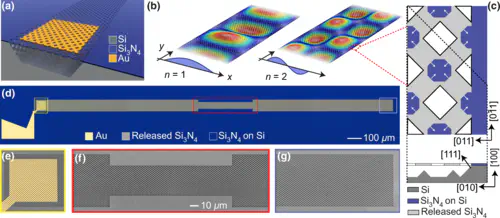 Image credit: E. Romero
Image credit: E. Romero
Abstract
Nanomechanical circuits for transverse acoustic waves promise to enable new approaches to computing, precision biochemical sensing, and many other applications. However, progress is hampered by the lack of precise control of the coupling between nanomechanical elements. Here, we demonstrate virtual-phonon coupling between transverse mechanical elements, exploiting tunneling through a zero-mode acoustic barrier. This allows the construction of large-scale nanomechanical circuits on a silicon chip, for which we develop a scalable fabrication technique. As example applications, we build mode-selective acoustic mirrors with controllable reflectivity and demonstrate acoustic spatial-mode filtering. Our work paves the way toward applications such as fully nanomechanical computer processors and distributed nanomechanical sensors, and exploration of the rich landscape of nonlinear nanomechanical dynamics.